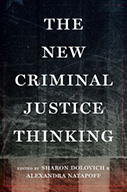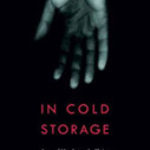The New Criminal Justice Thinking

Editors: Sharon Dolovich and Alexandra Natapoff
Publisher: New York: New York University Press, 2017. 346p.
Reviewer: Jack E. Call | July 2017
THE NEW CRIMINAL JUSTICE THINKING grew out of a conference sponsored by three law schools – UCLA, Loyola-Los Angeles, and NYU. Some of the articles in the book first appeared as papers at this conference. Those articles have shorter articles written in response to them, presumably by discussants of those papers at the conference. In addition, a few other scholars were invited to contribute to the book, and their articles have no responsive articles.
In spite of the fact that the conference that spawned much of this book was co-sponsored by three law schools, the book has a very distinct (and intentional) interdisciplinary flavor. Of the fourteen contributors, six hold Juris Doctor degrees, four hold both Juris Doctor and Ph.D. degrees, and four hold Ph.D.’s. Eleven of the contributors hold appointments at law schools. Not so very long ago, law professors – including many of the most active legal scholars – were largely either unaware of the existence of the growing body of empirical literature or chose not to refer to it in their writings. It is common now to see frequent references to empirical literature in law journal articles, and this book provides further proof that law professors are now very cognizant of this body of literature.
The purpose of the book, as expressed by the co-editors in their introduction, is to “offer a variety of thick and nuanced models for making sense of the legal processes, social institutions, and political dynamics that together shape the reality on the ground.” (p. 2) However, like so many edited books, there is no clear common theme. Much of the “new criminal justice thinking” supposedly reflected in the articles in this book is not all that new. (See, for example, the discussion of the penal pyramid below). Most of the responsive articles are not terribly helpful. Sometimes the brevity of the responsive articles makes their primary points difficult to discern. Perhaps the authors would have benefited from more space to make their arguments clearer. In other instances, the connection between the primary article and the responsive article was not readily apparent and seemed only tangentially related to the primary article.
This is not to suggest that the book as a whole lacks merit. There are five particularly strong primary articles that provide the basis for the bulk of this review. In addition, two of the responsive articles bear mentioning as well.
Rachel Barkow’s chapter on “The Criminal Regulatory State” begins by noting the massive increase in “the carceral state” in the United States. Why, she wonders, are nearly seven million Americans under criminal justice supervision “when studies show that [the increase in incarceration] is counterproductive at fighting crime, imposes enormous fiscal and social costs, is particularly concentrated on poor communities of color, and does not serve the same retributive ends.” (p. 35) Her answer is the criminal regulatory state.
Barkow argues that the criminal process has come to function like an administrative regulatory process. Prosecutors function more like managers of an administrative agency, rather than ministers of justice who give careful consideration to individual cases. They develop a kind of tunnel vision that keeps them so focused on the need to process cases that they fail to appreciate the “tradeoffs and downsides” created by their actions. The large number of cases processed leads to an unhealthy emphasis on efficiency. This emphasis combines with a desire to treat everyone equally to create a “skepticism about – if not hostility to – individualized assessments.” (p.36) The result is “a push for mandatory, one-size-fits-all sanctions that focus on the offense, not the offender.” (Id.)
One of the significant problems with this phenomenon is that many of the usual countervailing forces that hold administrative agencies in check are absent in the criminal process. Criminal justice regulators are not subjected to the counterweight of a politically strong regulated entity. When the Environmental Protection Agency tries to control automobile emissions, for example, it will meet resistance from several powerful, wealthy automobile manufacturers. Criminals are an obviously weak group politically with few significant advocacy groups to push back against criminal justice regulators.
Another factor in the failure to constrain criminal justice regulators effectively is the role of the courts. “Judicial review in the civil regulatory context is fairly robust,” while courts play very little role in controlling criminal justice agencies. (p. 43) The final factor is the absence of any meaningful review of criminal agencies by other executive branch agencies. Barkow cites as an example at the federal level, the role played by the Office of Information and Regulatory Affairs in reviewing the actions of administrative agencies to evaluate whether the benefits of their actions exceed the costs. Criminal justice agencies seldom, if ever, receive this kind of countervailing review.
Barkow sees some hope for a change in the dynamic that permits the criminal regulatory state to persevere. The dynamic could change if public attitudes change in such a way as to strengthen the position of the regulated entity (persons accused of crimes). She sees some signs of such a change in the recent public attention given to the large number of imprisoned persons (and the associated costs), recent bipartisan calls for criminal justice reform, and concerns about racial justice. She also notes an increased “concern with evidence-based decisionmaking and cost-justified decisions in criminal law,” as well as some signs that the Supreme Court may play a greater oversight role. (p. 46) In support of this latter observation, Barkow mentions Supreme Court decisions limiting the severity of punishments for juveniles, emphasizing the need for effective counsel in plea bargaining, and limiting the ability of legislators to bypass the role of juries when they create mandatory sentencing guidelines.
Although most of the articles responding to the primary articles are not terribly helpful, the two articles responding to Barkow’s contribution are an exception. Daniel Richman suggests in “Disaggregating the Criminal Regulatory State: A Comment on Rachel Barkow’s ‘The Criminal Regulatory State’” that Barkow’s focus on the criminal regulatory state needs to be augmented with more attention to what is going on at the local level and the variation that exists there. He believes that fiscal restraints are going to bring about changes at the local level.
In his article “Improve, Dynamite, or Dissolve the Criminal Regulatory State,” Stephanos Bibas suggests three possible ways to ameliorate the problem of the criminal regulatory state. One approach is to refine the way criminal justice agencies operate to make them more like administrative agencies (some of these changes have some merit, but they would be mere incremental changes). Another approach is to blow up the agencies and radically change the way they operate. The final way of mitigating the harms caused by the criminal regulatory state is by “loosening or dissolving the machine.” (p. 61) Bibas favors the last approach and advocates “injecting more local democracy and more popular moral judgment.” (p. 66) He generally advocates a larger role for laypeople in the criminal justice process, but he is unclear as to how to bring that about. (Bibas has been in the news recently. On June 7, 2017,President Trump announced that he will be nominating Bibas to be a judge on the Third Circuit Court of Appeals).
The second primary article of significance in this volume is Alexandra Natapoff’s “The Penal Pyramid.” Natapoff uses the penal pyramid as a heuristic device to answer the question of how “law interact[s] with social context to produce all the different criminal practices that make up the system we actually have.” (p. 75) The pyramid posits that as we proceed from more serious to less serious crimes, the system becomes less influenced by legal factors and more influenced by extralegal, sociological factors, such as race, gender, and class.
At the top of the pyramid, the system works as textbooks have traditionally suggested it is supposed to work. Criminal defendants are represented by lawyers who take their role very seriously because the stakes are high. Formal legal rules define the process and often dictate the outcome. However, as we proceed town the pyramid toward less serious crimes, the stakes are not as high and the incentives to fight charges vigorously are diminished greatly. The result is Barkow’s criminal regulatory state in full bloom. Outcomes are negotiated between prosecutors and defense counsel (usually a public defender or appointed counsel), often with little regard for either the legal or factual strength of the prosecution’s case.
Natapoff concedes that “[i]n a very general sense, the pyramid is old news.” (p. 79) (It is at least as old as Friedman and Percival’s Criminal Justice Wedding Cake, popularized by Sam Walker’s Sense and Nonsense About Crime, Drugs, and Communities, although neither of these works are cited by Natapoff). Her primary contributions to discussions about the pyramid are three-fold. First, she stresses that offense severity and class (as opposed to race) have received insufficient emphasis. Second, the role of defense counsel has often been misperceived. “[T]he mere failure to provide counsel does not fully account for the social inequities of the criminal process. Conversely …., providing counsel alone is not enough to insure lawfulness for all defendants.” (p. 86)
Her final important point deals with the enduring academic debate about the explanatory value of legal principles versus sociological principles. She views the debate as “a fundamental theoretical disagreement about what the criminal system is for.” (p. 88) The explanatory power of the penal pyramid is to suggest “that both perspectives may be right, just in different places.” (p. 88) The pyramid may be “old news,” but Natapoff provides some useful new perspectives on it.
The third significant primary article in the book is Sharon Dolovich’s “Canons of Evasion in Constitutional Criminal Procedure.” Dolovich suggests that there is a huge “gap between constitutional meaning and constitutional implementation in the criminal context” and that courts are largely ineffectual in substantially regulating the criminal process. (p. 114) She argues that three “categories of doctrinal moves” contribute to this failure of judicial control. (p. 116) 1) Avoiding the merits of a constitutional claim (procedural default being a prime example). 2) Ruling for the government in spite of a constitutional violation (qualified immunity and harmless error being prime examples). 3) Using evasive techniques to avoid the basic question presented in a case.
The article focuses on the latter stage. It contends that deference to other government actors, presumptions that certain legal requirements have been satisfied, and substitution of another question for the real question in a case are the three canons used to evade the merits of a case. Dolovich then uses four constitutional claims – the right to effective assistance of counsel, the right against excessive sentences, the right to prison conditions that do not constitute cruel and unusual punishment, and the right against racial discrimination in the selection of juries – to illustrate the canons at work. Dolovich concedes that none of these principles are problematic in isolation, but collectively they have resulted in a situation where the state nearly always wins in criminal cases, without the careful consideration of constitutional values.
The fourth significant primary article is Mona Lynch’s “The Situated Actor and the Production of Punishment: Toward an Empirical Social Psychology of Criminal Procedure.” Lynch advocates the use of social psychology principles to develop a better understanding of contemporary, every day decision-making by key criminal justice players. She argues that criminal justice decision-makers are situated actors, whose behavior is shaped, if not determined, by “immediate context, local culture, and broader structural conditions.” (p. 202)
Lynch also proposes “three categories of inquiry that are ripe for development.” (p. 209) 1) The process whereby legal changes become transformed into organizational imperatives. 2) How criminal justice actors come to conceptualize key criminal matters (such as the going rate for various offenses). 3) How extralegal, social psychological influences create discriminatory actions by criminal justice actors.
Lynch illustrates the value of her approach by describing a controversial decision in Cleveland to charge all persons found to be in possession of drug paraphernalia with drug residue on it with a felony (even though neighboring jurisdictions were charging misdemeanors in these situations). She suggests that this experience in Cleveland raises questions about how the drug arrest policy came into existence and became the common practice of the police department, why prosecutors condoned the practice, and why the police and prosecutors resisted efforts to change the policy when other political actors pushed for change after the racially disparate impact of the practice became widely known. The use of social psychology principles and methods can help answer questions like these.
The last significant primary article is Jonathan Simon’s “The Second Coming of Dignity.” Simon calls for supplementing the legality principle with a dignity principle. Simon defines the dignity principle as a rule that “[t]here shall be no crime and no punishment without respect for human dignity.” (p. 275)
Dignity as an important legal principle was endorsed by the United States when it ratified the Universal Declaration of Human Rights. The principle undergirded much of the work of the Warren Court, but it lost favor before the Supreme Court during the late 1970s, 1980s, and 1990s. Simon sees a resurgence of the principle in the Roberts Court (although he cites only 4 cases in support), most notably in cases upholding same-sex marriage and the right of consenting adults to engage in sexual practices of their own choosing.
Simon recognizes that dignity can be criticized as too ambiguous a concept to be of great value in determining legal outcomes, but he views the idea as no less clear than other constitutional principles that underlie much of the constitutional work of the Court, such as due process, equality, or liberty. (p. 285) He concludes with a call for utilization of the dignity principle to decriminalize most possession offenses, impose meaningful restrictions on police discretion, and adopt sentencing schemes based on restorative justice.
As with many collections of disparate works, THE NEW CRIMINAL JUSTICE THINKING is far from a perfect book. However, it offers several articles that will challenge the reader’s thinking and deepen the reader’s understanding of how the criminal justice works. By that standard, the book clearly succeeds.
REFERENCES
Friedman, Lawrence and Percival, Robert. 1981. The Roots of Justice: Crime and Punishment in Alameda County, California, 1870-1910. Chapel Hill, NC: University of North Carolina Press.
Walker, Samuel. 2014. Sense and Nonsense About Crime, Drugs, and Communities. Stamford, CT: Cengage Learning.
Jack E. Call, Professor of Criminal Justice, Radford University


